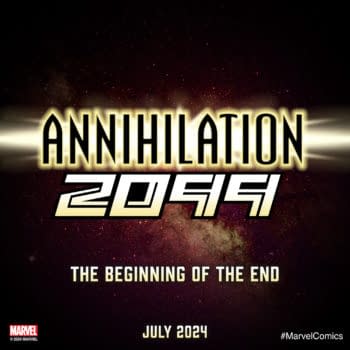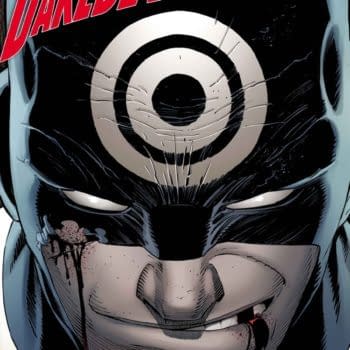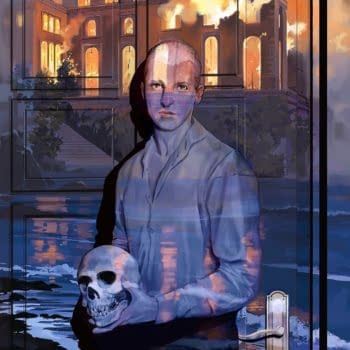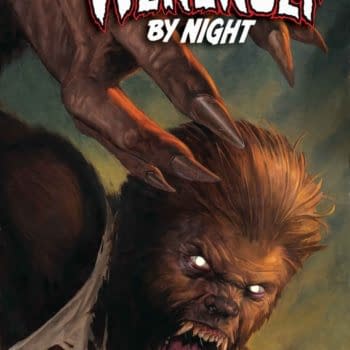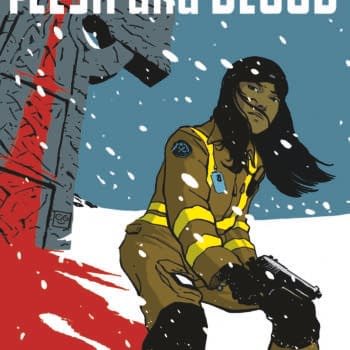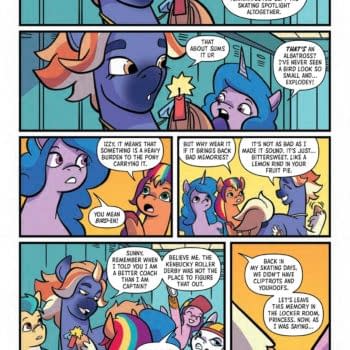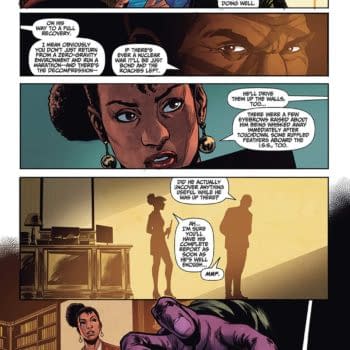Posted in: Comics | Tagged: brian miller, Comics
Brian Miller Gets Jesse Jamesed
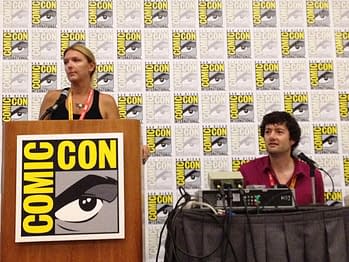
Brian Miller is not a household name in the comic book world. However, after reading this article you'll come to realize Brian has most likely been in your comic book collection for quite a long time. His work in the digital comic world is highly viewed as one of the best and his reputation as a community leader is surpassed by very few. His recent views on the treatment of creators at some of the bigger cons has sparked much interest on both sides of the fence. I recently caught with Brian and discussed a large amount of topics. He took some time from his very busy schedule to answer all my questions for you the Bleeding Cool Fans.
Tell us where you're originally from?
I was born in a suburb of Kansas City called, Exclesior Springs, Missouri. I loved artwork from a very young age and coloring with crayons in kindergarten was my favorite activity. In grade school I earned the nickname, Marker Happy, due to the fact that my hands were typically stained rainbow colors from Crayola's finest felt tips. The great thing about growing up just outside of the city was lots of nature to explore. Woods, creeks, lakes, and farm fields were a great escape from chores and homework as a kid. I would take a sketchbook with me and draw interesting trees and rocks then come home and paint them from the sketches. Most of my free time at home was spent creating artwork and trying to learn more about art. Bob Ross and William Alexander were practically my babysitters care of PBS.
Did you read comics growing up?
My first interaction with super-heroes came from toys and cartoons. The world would stop on Saturday morning for Super Friends. I had Batman & Robin Mego figures and the Batmobile and this hard plastic Spider-Man toy that could slowly climb up a fishing line like spider web. I'm not sure at what age I discovered comic books but I remember receiving a box of second hand comics, maybe 20 of them. I read them cover to cover. Spider-Man, Green Arrow, World's Finest. and stuff like that. I was hooked, but it was hard to find comics in my small town so garage sales are where I found most of my comics. I remember talking my dad into letting me have a new Micronauts comic I saw on a spinner rack at a store in the city. Until then all I had known were super-hero comics and then this sci-fi story opened up a whole new world for me. My dad was into cars and I would point out the Mustangs, Corvettes, and other cars drawn into comics and he seemed to like that. A few years later I discovered Dare Devil, The Man Without Fear, and my world was rocked again. The Kingpin was a much more imposing villain that I was used to reading and the stakes seemed higher. All those early comics influenced me in a big way. I can still see some of the covers if I close my eyes and concentrate.
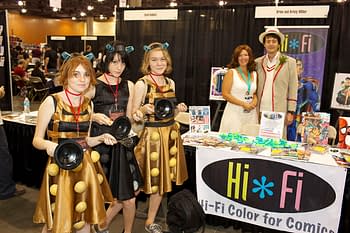
Adrienne Roy had the biggest impact on me. Her color choices were sublime. She used warm and cool color combinations to indicate mood and emotion in a way few others were capable of. Her work on Batman was genius and some of what she did then we could never get away with now. Today we are forced to be more realistic where Adrienne could be more evocative. I would be remiss not to mention Lynn Varley as it was her work on Dark Knight Returns that pulled me back into comics in my teenage years. Next on the list has to be Steve Oliff, he is arguably the father of all digital color. I was fortunate enough to interview him for the second book Kristy and I authored, Master Digital Color, and he posses a trait that I find many great color artist have, he never deals in the impossible, if he can dream it, he can figure out a way to bring it to life on the page. Steve's work on Akira, Batman, and Spawn were all groundbreaking and influenced digital color for the next decade.
Have you always wanted to be a colorist or did you try other aspect of the comic book business first?
I'm a painter first and foremost and I try to bring this to my coloring. I thought I would be a fine art painter because that is what they teach you in school. I kept coming back to more pop-culture imagery like pulp fiction covers, movie posters, sci-fi magazines, fantasy art by Frazetta and everything in between. What I didn't realize at the time is that I was being drawn toward visual storytelling. That is what interested me most.
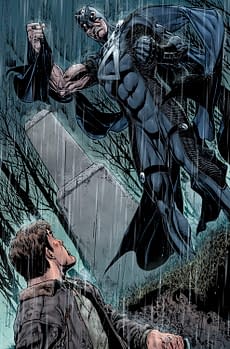
How was Digital introduced to you?
My first experience seeing a comic colored digitally was Akira colored by Steve Oliff. I remember opening the cover and seeing the colors for the first time. By today's standards the gradients and color blending would seem tame but at the time it was like holding an iPhone in your hand when everyone else still had old rotary dial phones. It was that revolutionary in it's time. I was still in high school and was already doing crude photo retouching and digital illustrations using the black and white Macintosh computers at school, so I had some idea what was going into his work. Seeing Steve's colors on Akira ignited the spark in me that an entirely new world of digital art creation lay ahead.
Did you accept it at first or where you skeptical about it as most tradition old school creators have been in this new field?
I think I was in the right place at the right time of my life. People ask me, "How did you decide to start coloring comic artwork with the computer?" and my answer is, "because no one told me I couldn't." What I mean by that is I had already been experimenting with computer art for a few years and coloring comic artwork on the computer seemed like a natural progression. I had seen Akira and a few other early digitally colored comic books so I knew it was possible, I just had to figure out how to do it. The software I had used up to that time had all been black and white. My friend had purchased a new color Macintosh and a scanner that came bundled with Photoshop 2.5. While he was scanning his art and showing me the software I realized Photoshop could be used to color artwork. I started experimenting and one thing led to another. There was no one in my life to say, you can't do that, you have to do it this way instead.
When I started taking samples to comicons all of that quickly changed. For every person who saw the potential of digital color there were 2 or 3 from the old guard who would tell me I was crazy, digital color would never catch on, it was just a fad, and stuff like that. I had one very well known creator flip me the bird and tell me I would never work in comics. One of the major publishers said they would never switch to digital color and I should learn the old ways. Lucky for me the indy publishers were more open to this innovation than the big two and I was fortunate enough to color a lot of covers and a few comics for them. Image comics was the first major publisher to embrace digital color and that changed the face of publishing forever. The writing was on the wall, digital color was the future. There was no going back now, it was only a matter of time.
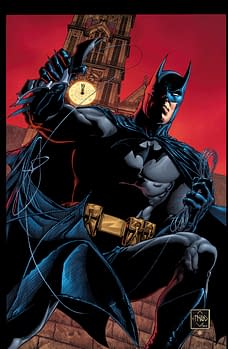
I founded Hi-Fi colour design in 1998 after leaving my day job as a creative director to work in comics full-time. The studio started with two penciller/inkers, a layout and lettering person, and me handling colors and running the day to day business operations. By 1999 Hi-Fi was coloring major comic book titles for Marvel, Chaos, Crusade, & Dark Horse, along with covers for Terry Moore's Strangers in Paradise. I brought two interns into the studio and started teaching them to color comics using the methods and techniques I had developed over the years. Hi-Fi was also penciling a few stories for The Simpsons comics and a few indy comics at the time. The coloring really exploded and working as a team we built Hi-Fi into one of the top color studios. In 2001 Hi-Fi moved to Phoenix, Arizona and continued to focus on visual storytelling while making friends with the incredible comic book creator community here. We currently employ 40+ artist and provide color, paint and illustration services for major publishers in the US and Europe.
What are some of the main titles you have worked on that our readers would be familiar with?
This is a tough question as we are lucky at Hi-Fi to have worked on hundreds of amazing titles over the years. I would say the top 20 comics people most know Hi-Fi for are:
Birds of Prey, Booster Gold, Cable, GI Joe, Green Lantern, JSA, Lady Death, Micronauts, New X-Men, OMAC, Sgt. Rock, Shi, Spider-Man, Strangers in Paradise, Superman, Transformers, Uncanny X-Men, Wolverine, Wonder Woman, World's Finest.
Do you have any type of correspondence with the Artist or Writer during each project?
This depends on the book but I find the most successful projects are those which I am in contact with other members of the creative team. Comics are all about collaboration, making a project that incorporates the strengths of each creator. When writer and art team can work together to tell great stories the fans and publishers win. As an example Dan Jurgens is taking over writing and pencilling duties on The Fury of Firestorm starting with issue #13. Dan and I communicate ahead of time and discuss how we want this new take on Firestorm to look and what color elements are most important and which should be played down and a whole host of other story elements where color can play a role. His input helps set expectations and gives me more insight into his goals for the story beyond what is on the printed page. When the team at Hi-Fi and I work on the colors we can give Dan the results he is looking for which brings more clarity and impact to his story.
Tell us about How to Paint Comic Books with the iPad ?
The idea for the book really came about on a trip to NY to meet with clients. I picked up an iPad 2 on the way to the airport and by the time we landed in NY I had finished a rough concept painting for a book cover. I was able to import that rough painting back into Photoshop on my iMac and with some finishing touches it looked as good or better than many of the cover paintings created on the desktop. I talk to a lot of comic book artists who feel chained to their desktops. Deadlines, rush projects, revisions all can keep you working on projects night and day. More and more artists are looking to the iPad as a way to fill in the gap between their home art studio and something basic like a paper sketchbook. Kristy and I wanted to write a book that would help artists turn their iPads into a portable art studio.
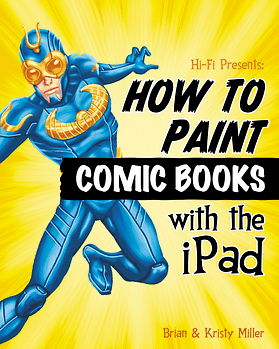
The great thing about How to Paint Comic Books with the iPad is the tutorials are no longer restricted by the limitations of print. As an example, I have a specific technique I like to show people for painting faces. In a print book we may be limited to 2-3 example images. With Multi-Touch technology we can include a series of images you swipe through to see the step-by-step progress of painting the face. And if you want more information tap again for video and see exactly how the example face is painted. This is just one example of what a multi touch book can do, and there is much more.
Kristy and I have worked hard to make How to Paint Comic Books with the iPad the best resource for artists who want to create with their iPads. We have been blown away by the response so far and the artwork people are creating is phenomenal. More and more artists are utilizing the iPad as part of their production process. From web comics, to character designs, and more the iPad is transforming into a mainstream creative tool. The people who are learning to sketch and paint on the iPad now will have an advantage when that transformation is complete.
Artists who are interested in How to Paint Comic Books with the iPad can visit the iBookstore where they can learn more, download a free sample tutorial and download the book.
Some might say that a traditional colorist in 10 years will be obsolete. You agree with that statement or will there be room for that form of artwork continually?
Somewhere an eight year is sketching and painting on their iPad right now. This eight year old may redefine what comics look like in ten years time. Will that future still require individual creators for pencils, inks, and colors or will comic book art evolve into something new and different? Only time will tell.
You have come out pretty strong about the Cons versus the Creators over the last week. You point out that some of the bigger cons reserve more space for the Media driven Movie industries or the high powered Publishers with little space provided for the creators. Can you talk about it some and give us some examples?
I asked fans to imagine a time, in the near future, when there are no comic book creators at comicons and that sparked quite a fire. The mere suggestion of this should be a wake-up call to fans and creators, as they are the ones who have the most to lose.
As a color artist I attend a handful of comic conventions each year. Less than I would like, but enough to see many shows are creating longterm relationships with fans and talent. There are some incredible conventions who "get it". They work hard to ensure creators are accessible to fans and pack their panels full of educational content about breaking into comics, drawing, coloring, writing, and more. These conventions understand when Hollywood comes and goes but a strong base of fans and creators will maintain the popularity of their show year after year. I love attending these conventions as they provide a real service to the larger comic book community.
The flip side of this are the shows who claim to celebrate comics but when dealing with them you realize they are not fans and they are not building a legacy for the future. If they provide little to no space for creators or price that space in such as way that few, if any, creators can afford it then they are part of the problem. There is a pay to play atmosphere evolving at some conventions and it creates a situation where fans only see the content someone paid to put in front of them. This is one major reason some creators are being squeezed out of some (not all) conventions. It is sad but true.
The bottom line is every creator I know is also a fan. Many creators are thrilled to see comics embraced by popular culture as it brings more attention to the characters and stories we love. What creators need is a level playing field at comic conventions. A chance to show-up, meet fans, and make new friends. Right now some conventions do this really well and some have dropped the ball.
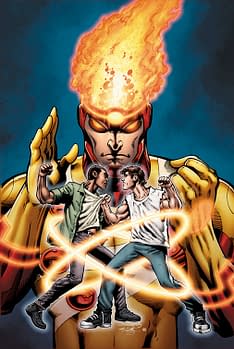
For one, creators as a whole have an image problem. Fans report some creators act like carnival barkers, so desperate to sell their wares the fans feel accosted walking up to their table. Other fans tell me they are put-off by the creator who has his head down working on convention sketches so intensely he doesn't acknowledge their existence. It would seem as a whole we creators need to learn how to better interact and communicate with every fan who comes our way. We only get one chance to make a first impression.
There is also the delicate subject of what qualifies someone as a professional creator? Some conventions demand proof of publication within the last 6 year while others are more lenient, and some shows have no qualifications. How does a convention keep the doors open to new talent without hurting working professionals? This is tricky and had to quantify. There was the example of the fraudulent artist who showed up at a convention a few years ago. He had stacks of bright colorful paintings to sell and bragged about all the comic book projects he had worked on. Only problem was, everything he was selling were copies of other artist work and all the stories he told were lies. Only when fans and pros united to confront this faker did he leave the scene. Should conventions have a vetting process for comic book professionals or should they sell their artist alley tables on a first come first served basis? This is an issue that pros constantly talk about amongst themselves one that can cast a shadow over a comic con that does not protect the integrity of the creator environment.
Another component is getting the creators more involved. Comic book artists are used to collaborating with others and creating a whole which is more than the sum of its parts. When shows involve creators in panels, signings, charity auctions, and other events that happen during the convention everyone wins; the fans, the creator, and the convention. The convention should communicate with the creative professional in advance what areas of the show they would like for them to participate in. The other end of the bargain means the creator must live-up to whatever they agreed to. This collaboration is very likely to result in a creator who feels more connected with the convention and is more likely to champion the convention. This also gives fans another way to interact with the creator away from the table where the creator may be focused on selling or sketching.
As an example, I participated in the Party Like a Timelord event at Phoenix Comicon this year and not only did I have a great time but I also made new friends who have become fans of my artwork and are now inviting me to other shows and events. I'm also telling more and more people to attend Phoenix Comicon because i was allowed to contribute in a new and unique way and had such a great time I can't contain myself. Long term this sort of collaboration between creator and convention is invaluable and it doesn't happen by accident, the Phoenix Comicon staff work hard to bring fans and creators together.
Kristy Miller is such a strong driving force for Hi-Fi Colour Design, and in her own right has made a very positive and brand name for herself in this industry as well. How does this make the marketing of your company and brand name much easier for you then someone trying to do it them self? Any disadvantages?
Anyone who has met Kristy knows she is pretty amazing. Kristy manages to juggle so many things at Hi-Fi and she is the main point of contact most people have with Hi-Fi. She jokes that I'm, "just the talent," because she is the one running the business which includes working with editors, publishers, convention promoters, and comic shop owners. Kristy does so much more than anyone knows. She develops new relationships with clients and works with them to ensure every project meets or exceeds their expectations.
Kristy and I work together on Hi-Fi branding. Everything we do is a team effort and when you see the Hi-Fi logo it represents the entire team of color artists here and we can share the pride when we see the Hi-Fi name on a comic book. Hi-Fi is also a symbol of quality for fans. When they see Hi-Fi in the credits they know the colors will be an integral part of the story and believe we are every bit as passionate about their favorite characters as they are. Hi-Fi is also becoming a trusted name in art education. Through our outreach programs with schools, the panels we present at comic conventions, and the art instruction books we create Hi-Fi is working hard to help the aspiring artist of today become the creative talent of tomorrow. These are the key areas Kristy and I work to market for Hi-Fi.
Kristy takes the lead for all Hi-Fi's one-on-one marketing efforts. She selects Hi-Fi give-aways for conventions and Holiday gifts for clients. Kristy comes up with the coolest stuff. Over the years we have given away Hi-Fi Frisbees, Magic 8-Balls, Etch-a-Sketch, drawstring back-packs, and more. Editors and fans will see us at conventions years later and say, I still have that Frisbee you gave me or, I drink coffee from my Hi-Fi mug every morning. Kristy just knows how to create a connection with people and make lasting memories.
If there is any disadvantage it would be we have little outside help. Few people really understand what Hi-Fi is and what we do. There are fans who have offered to help maintain and update our website or help with convention promotions and appearances. The creator fan relationship is much more personal than it was even 5 years ago. People follow Hi-Fi on Facebook and twitter and are know more about the comics and books we are working on during the creative process than before. Kristy and I have worked together so long we have a good idea what the other will do, we trust each other completely. We need to learn to put some faith and trust back into the hands of Hi-Fi's fans who want to help get the word out about all the cool projects Hi-Fi is involved with.
You recently did a class for a group of creators at a Tiny Army, a Arizona based community outlet for local creators, meeting. How important is your community in sharing your time to other creators? Is this a expectation or just a matter if you have time or not
Since day one fans have embraced Hi-Fi and the outpouring of support is beyond belief. Comics have given me a freedom to create and share stories with people the world over. Kristy and I consider it an honor to give back to the comic book community. One way Hi-Fi gives back is by supporting charities like CBLDF, Hero Initiative, and We Can Be Heroes. We also focus on creating a long term legacy by employing color artist today and training the next generation of talent.
Kristy and I have always presented panels on digital coloring at comic conventions we attend as a way to educate fans and aspiring color artists about the tools and techniques needed to work in comics. After one of these panels we were approached by a publisher and Hi-Fi Color for Comics was born. This book is used at high schools, colleges, and art schools in the U.S. and abroad. I've visited schools and helped them set-up these classes and even taught these classes locally during semesters when I could make extra time in my schedule. What I discovered is that digital art instruction in our schools is falling short for most students. Many digital art classes focus what I call, "button pushing," but never teach students how to think creatively. With Hi-Fi Color for Comics students are creating during the first week and must learn to make decisions about the illustrations they are working on. They learn to solve visual storytelling problems by exploring the possibilities of light, shadow, and color. By the end of the semester these students have created a portfolio of finished images they can show their friends and family or even present to prospective employers. This is part of Hi-Fi's legacy, to help foster the comic book creators of tomorrow today.
The Tiny Army meeting I attended recently focused on publishing and as someone who got my start in comics self-publishing with a friend, has been published by other companies, and is now self publishing digitally I felt a responsibility to share my experiences and answer questions for others. There is this misconception in life that for me to win, you must lose. I don't abide by that. I believe our creative community is like a mighty tree and the stronger the individual roots, branches, and leaves are the stronger the community is.
What are you upcoming events?
We have a few events on the schedule with more on the horizon. Fans can follow us on facebook and twitter to stay up to day and get sneak peeks at upcoming projects.
Twitter: twitter.com/hificolor
Facebook: facebook.com/
Cab Comics in Flagstaff, AZ for the Arizona Artist & Creator Signing September 15th 11AM-4PM
Emerald City Comic Con March 1-3, 2013
Phoenix Comiccon May 23-26 2013
Comic-Con International July 18-23
Where can people get a hold of you or your company?
Fans and creators can contact us and follow us here:
Twitter: twitter.com/hificolor
Facebook: facebook.com/
web: hifidesign.com
e-mail: info@hifidesign.comFinally, can you tell us three Creators you would have or would like to be a colorist for?I'm very fortunate in that I have been given the opportunity to meet many of my comic book and animation idols and color most of their artwork at one point or another during my career. At the moment I have the honor of coloring amazing artist like Jurgens, Van Sciver, Lopresti, and Perez every month. I feel like the luckiest boy on Earth. I think I will choose three creators I admire who I will never get to work with one-on-one, even if some day I am given the opportunity to color their artwork.
Jim Aparao. Jim's handling of Metamorpho was every bit as genius as that of Jack Cole on Plastic Man only Aparo doesn't seem to get the credit he deserves. Add to that Jim Aparo's amazing work on Batman and The Outsiders and how could I not want to color every page? I remember seeing the cover for Batman and the Outsiders #1 on a comic rack as a kid and I was simply blown away. The concept of Batman telling the Justice League, "Screw you guys, I'm starting my own team!" It was pretty bad-ass.
Alex Toth. Here is a guy who worked in comic strips, comic books, and animation and left his mark on all three. Space Ghost and Super Friends were Saturday morning staples for me and introduced me to super-heroes before I discovered comic books. While it would be fun to color his golden age work on The Flash, Dr. Mid-Nite, Green Lantern or The Atom what I would really like to color is his artwork for Eerie and Creepy horror comics.
Doug Wildey. Here is a guy who has a reputation as a bit of a grouch and by all accounts was not a pleasant man to work with. Yet he managed to create or work on comic strips, comic books, and animation beloved by kids and adults the world over. Johnny Quest, Tarzan, Sgt. Rock, The Saint, and Buffalo Bill. Doug loved the men's adventure style of stories. Doug also had an appreciation for all things mechanical and produced illustrations for Popular Science, Popular Mechanics, and Science Digest depicting futuristic ,machines and vehicles. I would be thrilled to color some of his original Johnny Quest stories.






